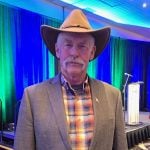Norbert Beaujot knows how to build a big seeding system.
The southern Saskatchewan maker of Seed Master drills has built wide machines for years and last year released a 90 foot design.
This week he went a step further with a 600 bushel fertilizer tank.
However, these bigger and wider systems come with their own sets of challenges.
One of them is feeding all the drill shank runs with granular fertilizer.
It’s a long way from a large tank to the ends of those drills, and it can be challenging to keep fertilizer flowing at rates of up to 200 pounds per acre at speeds of up to six mph.
Read Also

VIDEO: Ag in Motion documentary launches second season
The second season of the the Western Producer’s documentary series about Ag in Motion launched Oct. 8.
To meet these challenges, pairs of fans up to nine inches in diameter have been incorporated into the larger drills to blow the material up to 80 feet to reach the distribution manifolds. To run the big fans, producers are required to have the latest and largest in tractor hydraulic pump systems.
Lawrence Papworth of Alberta Agriculture’s Ag Tech Centre in Lethbridge has evaluated seeding systems and says one of the biggest challenges is keeping all that precisely measured freight moving inside the bigger machines, despite outside influences on the tractor.
“We see (drills) plugging due to slight variations in hydraulic flow. Those occur when tractors are lugging in soft spots, pulling up hill or when conditions toughen up in the field,” he said.
“Farmers will be using a tractor to capacity, especially when we are talking about the biggest drills or in areas where they apply the highest rates of fertilizer. There isn’t a lot of reserve for the machine to slug down and when they do, the hydraulic flow is reduced and bang, they’re plugged.”
Beaujot said unplugging a 40 foot machine isn’t much fun.
“Unplugging 80 or 90 feet is really not a good time. At those sizes, farmers are seeding 50 acres an hour. An hour to unplug is a lot of unseeded acres and that comes at a price.”
Beaujot’s Seed Master drills already had a gravity fed seed tank system with individual run metering located on the drill frame. This arrangement shortened the distance to the seed row and reduced the air supply needed to carry the material.
Beaujot decided that if he could further reduce the need for large fans, he could reduce the draw on tractor hydraulics and the threat of plugging.
Air seeder boxes have traditionally been pressurized by the hydraulically driven fans, ensuring stable feeds of material to metering systems and providing high capacity dispersion to the openers.
Gravity based systems require proximity to the drill, which is the case with Seed Master.
“I reasoned that if we could place the fertilizer at the drill and meter it there, we wouldn’t have the fan demand on the hydraulics and we’d be gentler on the product,” he said.
Instead of a fan on the cart, the new Seed Master Titan Three cart feeds its 600 bu. of fertilizer to the drill-mounted meters with a drag auger.
“It’s only on a slight incline towards the drill, and (its motor) draws about two or three gallons per minute (from the hydraulic system), a lot less than a big fan,” Beaujot said.
The auger moves the material to the front end of the cart hitch, where it dumps it onto a large flexible boot and then to the drill and metering system.
“From there we use a pair of six inch fans, about half the size of nines we might need without this approach,” he said.
“We pulled the cart behind 77 feet of drill on our own 2,000-acre farm this spring using a John Deere 9400. It had hydraulics to spare with the tractor having about a 35 gallon (per minute) system.”
Papworth said it makes sense to reduce the energy required to get the fertilizer to the ground, “especially as these drills get larger and the runs get longer.”
The Titan Three took about four months to complete from drawing board to field.
As the construction of the prototype began, the company realized its seeder cart was just a 600 bu. grain caddy with a delivery system.
“So we are offering an optional (high capacity) auger on it, as well as a fertilizer spreader attachment. That will make the cart into a multi season caddy for harvest or for farms, like in the U.S. corn belt, where they top dress a lot of their fertilizer.”
Papworth said making additional use of machinery investments is an issue that farm managers have tried to exploit.
“It’s difficult to do with a seeding unit. In this case, it’s a 600 bu. cart with a tarp on top. It is a good size for a variety of shuttling applications on the farm.”
Combined with the Seed Master seed tank mounted on the drill, a complete drill will have a 920 bu. capacity.
Corey Beaujot of Seed Master said the machine will plant a typical quarter section of prairie crops between fills.
Norbert said the equipment won’t be aimed at all producers.
“It’s a product for the larger farmer who wants to seed precisely that three pounds (per acre) of canola or that corn. We can deliver that,” he said.
“We couldn’t see a way to put that on a single cart frame and have it hold together well.”














